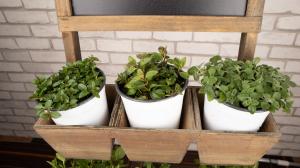Introduction
Tomatoes are one of the most popular vegetables for gardeners around the world, but they can be susceptible to a range of problems, including pests, disease, and damage from the elements. In this article, we’ll take a look at how to harden tomato plants so that they are more resilient and can survive adverse conditions.
Initial Care
When your tomato seedlings are still indoors, it’s important to take good care of them to ensure they are healthy and strong enough to cope with life outside. Keep the seedlings in a warm, light-filled spot, and make sure they receive plenty of water and nutrients. Once they have developed a few leaves, you can start to harden off the plants by gradually exposing them to outdoor conditions for a few hours each day. This will help them to adapt before being planted into the ground.
Planting and Support
When planting your tomatoes, it’s important to choose a sunny spot that has well-draining soil. Make sure you dig a deep hole and add some compost or fertiliser to the soil. Plant the tomato seedling deeply, so that the first set of leaves is buried. This will encourage strong root growth. Once the plant starts to grow, it’s a good idea to add a support structure, such as a tomato cage or stake, to help keep the plant upright.
Watering and Feeding
Tomatoes need plenty of water, especially during hot weather. It’s important not to overwater them, though, as this can lead to fungal problems. Aim to water the plants deeply once or twice a week, rather than giving them a light sprinkling every day. It’s also important to feed your tomato plants regularly throughout the growing season. Use a balanced fertiliser that contains nitrogen, phosphorus, and potassium, or make your own organic fertiliser from compost and other natural ingredients.
Pest and Disease Control
Tomatoes can be susceptible to a range of pests and diseases, including aphids, blight, and blossom end rot. To minimise the risk of these problems, it’s important to keep your plants healthy and well-fed. If you do spot any signs of pest or disease, act quickly to prevent it from spreading. There are plenty of natural remedies, such as neem oil, garlic sprays, and insecticidal soap, that can help to control pests without using harmful chemicals.
Mulching and Pruning
Finally, it’s a good idea to mulch your tomato plants with an organic material, such as straw, grass clippings, or shredded leaves. This will help to retain moisture in the soil, and prevent weeds from growing around the plants. You should also prune your tomatoes regularly throughout the growing season, to remove any dead or diseased foliage, and to encourage the plants to produce more fruit.
Conclusion
By following these tips on how to harden tomato plants, you can help to ensure a healthy, productive crop that can withstand adverse conditions. Remember to provide your plants with plenty of sunlight, water, and nutrients, and to protect them from pests and disease. With a little care and attention, you can enjoy a bountiful harvest of delicious, juicy tomatoes.

 how many times do yo...
how many times do yo... how many planted tre...
how many planted tre... how many pine trees ...
how many pine trees ... how many pecan trees...
how many pecan trees... how many plants comp...
how many plants comp... how many plants can ...
how many plants can ... how many plants and ...
how many plants and ... how many pepper plan...
how many pepper plan...































